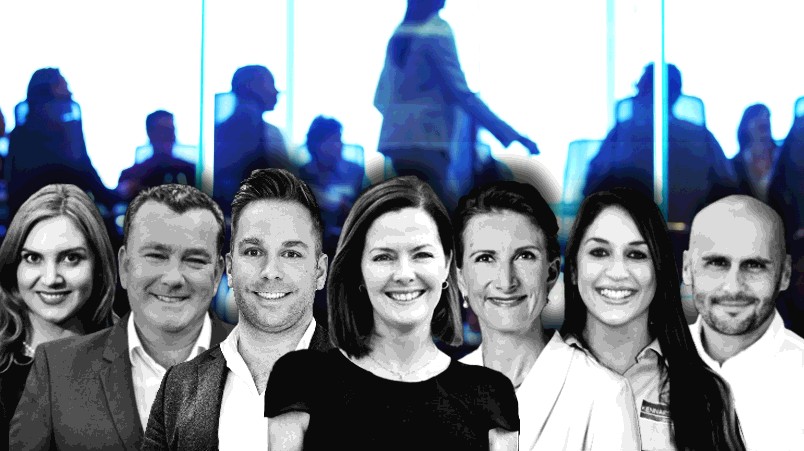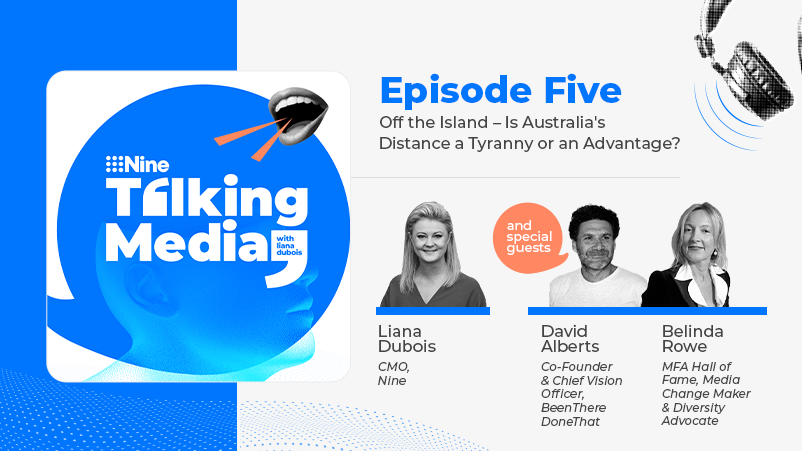70% of business transformations fail, says McKinsey. Digital transformations are worse, says Gartner. Guess where marketing, CX, and digital leaders are being asked to take charge? Challenges and success stories from the front line

L-R Bridget Gray, Michael Fagan, Matt Horn, Joanne Smith, Claudine Ogilvie, Manelle Merhi and Brian Vella
CustomerX: Customer-focused leaders are increasingly involved in product development and company-wide process change as they look to drive innovation that grows revenues and improves margins. That means managing organisational challenges from early stage start-up through to global scale. We reveal lessons learned at the front lines of innovation from companies including Blackmores, Compass Group, Country Road Group, Uber, Iconic, Village Roadshow, Kmart and Kennards Hire. And we identify the qualities boards are seeking from transformation leaders.
What you need to know
- Seven in 10 business transformation projects fail says McKinsey. Digital transformations are worse says Gartner, failing to deliver against expectations 80 per cent of the time, often due to poor governance.
- But for executives in marketing, CX, digital and ecommerce, there's no escaping the need to drive transformation and innovation in a world where technology disruption, ESG imperatives and regulators are constantly upending the rules.
- And the pay-off can be massive. Blackmores reimagined its approach to innovation and saw order of magnitude increases in new product revenue, while also growing margins and increasing the share of total revenue pie innovation delivers. Meanwhile, the executive who rebuilt (occasionally controversial) store layouts at Kmart cites sales uplifts at all but two of 300 sites.
- Yet innovation programs face cost and complexity challenges wherever you sit in the company maturity curve, says Country Road Group's head of customer and digital, who also implemented change programs during his stints at Iconic and Uber.
- Over at Kennards Hire, the catchcry is evolution not revolution. But that doesn't release leaders from the need to be brave and break the "always done it this way" mindset, says its marketing and CX chief.
- For AKQA's managing partner, executive leaders must focus on "Wildly Important Goals", and not get caught in the whirlwind of innovation for innovation's sake.
- Korn Ferry's Bridget Gray describes what boards are looking for from their transformation leaders.
Iconic is probably the most ruthless. One memory from this chapter was when they said to me, 'You live by the sword, you die by the sword.'
Michael Fagan, chief transformation officer of Village Cinemas, has spent his career in the uncomfortable world of permanent change. Starting with a lengthy stint in the consulting working at Accenture, he worked across operations and procurement at Kmart before rising to the role of chief technology officer.
"There are three big drivers of disruption and transformation," he told Mi3. "Regulatory change, cost and reinvention. Cost is the most common, having to reinvent your business is the least."
Whatever the motivation, all three inform the kind of dramatic risk/reward equation - and drive the subsequent organisation change - increasingly occupying the contemporary customer-focused executives' time.
Just how risky is such change? McKinsey famously noted 70 per cent of transformation projects fail. Technology sector industry analyst, Gartner, says it's worse in digital transformation: Its estimate show 80 per cent of organisations seeking to scale digital business will fail through to 2025. The analyst firm attributes failure to the lack of modern approaches to data governance. Likewise, executives we spoke with stressed the criticality of governance.
But the rewards make transformative innovation worth the conquest.
Blackmores chief marketing and innovation officer, Joanne Smith, didn’t have to wait long to learn her team had hit the bullseye. Charged with reimagining how the Australian natural health products company innovates, Smith has overseen a three-year transformation program that's led to order-of-magnitude improvements in new product revenue, improved margins, and doubled the share of innovation-led sales money pouring into the coffers of the near $2 billion market cap business.
Smith and the team tackled this during the most disruptive days of the pandemic. Early research into new product opportunities revealed people spending more time than ever on screens was rapidly increasing eye fatigue rapidly across all demographics and all markets. That insight led to creation of the Vision Care + Energy product line. In its first year, the product brought in several million dollars. This year, it's on track to pull in significantly more.
“When people experience eye fatigue, they experience overall energy fatigue," Smith says. "Researchers could have said people are on screens too much, here’s an eye product. But they went a little deeper and said there's a physical exhaustion that comes from eye fatigue. So Blackmores developed a product addressing both needs and launched it into every market we operate in."
It was a great example of a scalable innovation, says Smith. It's also bankable proof of the success of the three-year program transforming the way Blackmores innovates to ensure products are aligned with evolving customer needs.
“It's one of the most successful innovation launches we've had in recent years," Smith says. "We've also launched a sleep range onto shelves in Australia in the last three months that’s doing incredibly well. That'll launch it to our other markets as well.”
Smith describes the impact of innovation transformation on the business as profound. “It's now a concrete, tangible commercial growth driver meeting the growth agenda of the organisation, but in a really powerful way because it's sustainable,” she says. “And it's connected to a deep understanding of consumer needs.”
Smith joined Blackmores in 2019 and took on the role of driving the innovation transformation in 2020. Targets in the first year were exceeded then smashed in the second, 40 per cent ahead of the plan.
So where are we today? And what are we delivering? Then we set really clear targets against where we want to get to, and then use data to constantly update against those targets. That’s so critical for engagement and for people to understand whether we are on track or off track, and if we're on track, what are we doing?
For Smith, one of the most valuable lessons of the program is the importance of data.
“It is very obvious to say, but it's so critical in transformation," she says.
As to setting the innovation agenda, it's firstly about establishing the baseline. ”Where are we today? What are we delivering? Then we set really clear targets against where we want to get to, then use data to constantly update against those targets. That’s so critical for engagement and for people to understand whether we are on track or off track, and if we're on track, what we are doing right," Smith says.
Blackmores focused on several areas in particular, tracked on a monthly basis. The first was net sales from innovation.
“We also measure gross margin as we wanted to make sure we were delivering premium innovation into the market accretive to our group average," Smith says.
Another critical metric was how effective Blackmores was at meeting deadlines, and how disciplined teams were around delivering against set timelines. The final metric was percentage of net sales innovation contributes to total sales as a business. Over the last three years, this figure doubled from single digits into the mid-teens, Smith says.
The scale of revenue gains for individual innovation-driven initiatives has also grown dramatically. Smith declined to provide specific numbers but indicated the change was in the order of several hundreds of dollars to several million - an order of magnitude improvement.
One of the key drivers was being able to have comparable and auditable food waste management across multiple countries. Often it's difficult to audit without one source of the truth. Our transformation enabled us to go back with trusted numbers for shareholders
Coping with operational complexity
With revenues of $650 million and 1200 staff spread across 13 countries, the Blackmores experience reveals another key innovation challenge: With scale comes complexity. Suddenly, that simple dot-point in the strategy pack for the board can trigger massive amounts of planning and work in reality.
At the start of the decade, food giant group, Compass Group, set itself the goal of reducing food wastage by 50 per cent across its APAC region by 2025 as part of its ESG commitments. That was a big call to make under normal circumstances. But then the pandemic struck, overlaying huge upheaval across operations, consumer sentiment and staffing on top of what was already a major and complex transformation project.
While many of Compass’s clients shut down, other in areas such as defence, oil and gas, mining, and hospitals needed more support than ever.
This context is important to understand, says Claudine Ogilvie, who at the time was Compass' APAC director of digital and innovation. These days, Ogilvie is a director on the board of Cuscal. Her career has provided wide experiences in the world of transformation, including from previous roles as CIO at Jetstar and Ridley Corporation.
Compass is a large and dispersed business operating in more than 10 different countries across the region. Characteristics within countries such as culture and scale of operations vary widely. These are also typically low-margin businesses, especially at the site level, so it is not the kind of environment where you can spend your way to an outcome.
“We were able to overcome some of the financial constraints with economies of scale," Ogilvie tells Mi3. For instance, Compass was able to negotiate significantly lower costs with service provider, Leanpath, off the back of a 10-country deal.
“The project to reduce food waste also reduced food costs, and given Compass’s scale even a 1 to 2 per cent reduction is impactful,” she says.
But for the transformation to work, Ogilvie and teams across Compass had to overcome a lot of complexity. There was a massive difference in site sizes for instance, between a hospital or a defence facility versus a tiny site in Japan. It was clear a one-size-fits-all approach was not going to cut it. The business instead ended up with four different tiers of technology solutions and processes reflecting different regulatory and cultural nuances.
Food waste reduction also had to be verifiable, and Ogilvie notes a key driver was being able to have comparable and auditable food waste management across multiple countries.
"Often it's difficult to audit without one source of the truth. Our transformation enabled us to go back with trusted numbers for shareholders," she says.
Change management proved especially challenging during the worst of the pandemic as the hospitality sector struggled to find people. “Staff turnover was astronomical," Ogilvie says.
The company was ultimately able to impact 70 per cent of its food costs through changes at 20 per cent of its sites. There was also an unexpected upside as new products emerged and customer satisfaction benefits were realised. For instance, instead of throwing orange peels away, chefs started repurposing leftover ingredients to make new products such as Chutney and Marmalade.
“People like to know where the food goes, so yes it helped with customer satisfaction,” Ogilvie says.
Fundamentally let's call Uber utility transport business transport. And iconic to some degree, was really is just playing the selection and convenience game. So in that context, it's just about ruthlessly optimizing the funnel and the answer is always whatever the technically correct answer is.
Ruthlessly optimising the funnel versus brand value
Country Road Group GM Customer and Digital, Matthew Horn, has ridden the innovation curve at all points of maturity, first at The Iconic in its start-up phase, then at Uber as it scaled towards the digital giant it's become. At Country Road, he's now in a mature retail business with a strong ecommerce pedigree nonetheless, at least in its early days.
"The Iconic was probably the most ruthless innovation example," he says. "One memory I have from this chapter was when they said to me, 'You live by the sword, you die by the sword'."
A degree of ruthlessness was also a key element of success at Uber where it was applied to talent management.
For Horn, determining the best approach to innovation comes down to context.
"Fundamentally, let's call Uber utility transport business transport. And The Iconic to some degree was really just playing the selection and convenience game," he explains. "So in that context, it's just about ruthlessly optimising the funnel. The answer is always whatever the technically correct answer is."
In taking on the innovation challenge at Country Road, Horn points out the importance of brand purpose as a big part of why the business is successful. "It's interesting to engage in a business where an intangible asset is actually at the core of our business and the secret to success," he says.
"Often the answer we would have applied at The Iconic or Uber is not the right answer at Country Road, because there are broader considerations. For instance, are we supporting a content strategy to tell our story of sustainability or quality? Inserting that kind of content into the path to purchase actually creates friction. That would never appear in Uber if there was ever an equivalent.
"We talk often about brand being elevated: What does that actually mean? How do you show up and be perceived as elevated in a digital context? Compare that to the other end of the spectrum like Amazon, where it's just pure convenience and the magic of one-click away. That's not what we're solving for at Country Road - that's not necessarily the right answer for a business like ours."
The culture is underpinned by a philosophy of continuous innovation, trust and courage in thinking differently, trying something new and having a crack. We literally use that language, Well, let's have a crack.
Reflecting culture
It shows there's no one-size-fits-all model for transformations. Often, the best approach is the one that best reflects the culture.
At Kennards Hire, a privately owned equipment hire company with 200 sites and branches across Australia and New Zealand, the mindset is evolution, not revolution, says GM of marketing and customer experience, Manelle Merhi.
"We genuinely believe in incremental growth and continuous growth and sustainable growth, so we don't have formalised teams necessarily that look to that entrepreneurial mindset to innovate," she says. Instead, innovation is organic.
"The culture is underpinned by a philosophy of continuous innovation, trust and courage in thinking differently, trying something new and having a crack. We literally use that language, Well, let's have a crack.
"I think the mindset has to be, don't take the big leap. Think about the next step, and have the philosophy that we want to do things one step better. "
But while Kennards Hire may take a different path on the route to progress, there are some aspects of its mindset that would be just as familiar to big bang change architects. One of these is thinking about things differently, as opposed to being stuck in traditional mindsets.
"That mindset of we've always done it this way is one of the biggest drags on an organisation because it breeds complacency," Merhi says. "You need to have the ability and the courage to ask, how can I think about it differently?"
Managers and staff both have to be aligned on the way forward, she continues. "Leaders have to implement a culture of trust, where people have no fear of making mistakes and can think outside of the box. But they also need the ability to hone in and understand what problem are we trying to solve. Because a lot of innovation springs from the discipline of actually understanding the problem," Merhi says.
"Have the philosophy and the courage to ask, 'How can I think of it differently while staying within guardrails? If leaders can implement that type of culture where their people are coming to them with solutions, there's so much innovation in that alone."
For the staff, Merhi sees it being about clearly articulating the problems and recognising there may be a set of solutions.
"Back it up with data and find a sponsor with a bit of courage and entrepreneurial [flair]," she advises.
I remember I was talking with Kmart and Target about Kmart using Target's warehouse for Christmas. How do we figure this out more? We're gonna do like a two to three-week program? What can you do this afternoon? That's a very important question. What can you do by 5 pm? It puts a constraint right. You can't change the technology in that timeframe so you are forced to experiment in a low-tech way.
Not every change is popular with every customer, but sometimes you have to punch on through, as Fagan discovered during his time at Kmart, where he introduced the new store layouts with checkouts in the centre. It's something he acknowledges, only half joking, was "much maligned".
"If you think about that format, we were able to live a much better on-shelf availability for customers. Kmart is a self-managed shopping experience for shopping, so you need to have your products available on the shelf, in the right size, at the right time when you are in the store. How do you develop a great self-shopping experience? That's what that format did," he says.
Proof could be found at the cash register. Kmart saw sales uplifts in all but two of 300 stores nationally. The two stores where it didn't click had very specific demographics.
It's almost three years since Fagan left Kmart and the retailer has recently started testing registers back at the entrance in some stores. Customers are now complaining about that change according to media reports, proving in addition to everything else, running a big transformation regime also demands a serious sense of humour.
Both Horn and Fagan believes transformational skills are transferrable across the industry. "I've gone from retail into cinemas and theme parks. Those kinds of skills are transferable," Fagan says. "It's as much about mindset than anything else. I'm not a construction guy, but I was able to lead construction teams to get better outcomes."
Getting such buy-in means finding ways to get stakeholders' folders on customer outcomes.
"I remember I was talking with Kmart and Target about Kmart using Target's warehouse for Christmas. How do we figure this out more? We're going to do a two to three-week program? What can you do this afternoon? That's a very important question. What can you do by 5pm? It puts a constraint in play. You can't spend any money. You can't change the technology in that timeframe so you are forced to experiment in a low-tech way. Don't go and write a paper about it. Just go do it."
It's very easy to be stuck in that whirlwind. You're not really moving the needle, but you're still really busy doing lots of activities and feeling like you're improving the customer experience. But really, you're overlooking the things that really matter to them.
AKQA managing partner, Brian Vella, says that among the customer and prospect set, there are some common characteristics that signal whether a brand possesses the kind of genuine empathy that enables them to innovate successfully around that customer needs, or whether they still have a way to go on the journey.
"Ultimately it's about ambition, " he says. "You can quickly tell whether somebody's looking for an incremental improvement or a step change. It becomes quite clear, through the conversation, whether they are thinking short term or after a more integral outlook. That's probably the first giveaway. And we prefer clients who have a bigger ambition and have a longer-term vision."
Boards and breakthrough results
The C-Suite suite can also get caught up looking at wrong metrics, he adds, even when they have the best intentions.
"I spent some time at Stanford where I learned about a concept called breakthrough results. It's about identifying and setting those two or three wildly important goals and having them sit in an organisation."
What sits alongside those goals is what's called the whirlwind, Vella warns. "It's very easy to be stuck in that whirlwind. You're not really moving the needle, but you're still really busy doing lots of activities and feeling like you're improving the customer experience. But really, you're overlooking the things that really matter to them."
Simplification, modernisation, and optimisation, are the three most common competencies boards and execs are looking for when they go to market for a new transformational leader.
According to Bridget Gray, senior client partner, Korn Ferry, "Simplification, modernisation and optimisation are the three most common competencies boards and execs are looking for when they go to market for a new transformational leader."
She tells Mi3 that with customers growing expectations of products and services coupled with high-profile data breaches; balancing speed and innovation with security posture are tablestakes for making it to the top of today’s shortlist.
"Strategic selection of the most appropriate digital transformational pathways and the ability to build engagement, capability, and followship are highly sought-after behaviours of this new contemporary leadership profile," Gray says.
The rise of digital channels has added another dimension, she adds. "Elevated awareness and adoption in digital technology has led to an increased appetite for organisations to select leaders who can advise the board and executive to navigate the distraction of the latest buzz words and trends, and pragmatically prioritise technology enablement, partnerships and approach."



